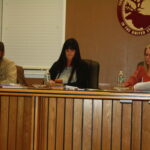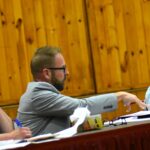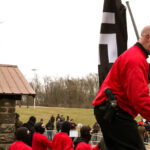Special to The Star-Herald
The years of 1947-1950 were very important in the development of the Presque Isle School System and the construction of the current high school. Rural schools were being closed everywhere. On Sept. 22, 1947, the opening of the school term, it was announced that the Glidden and Reach Schools would be closed because of reduced enrollment, and the Normal Avenue School, a four-room unit occupying temporary quarters in the north section of the war time dormitory units at the rear of the Normal School campus was opening.
This resulted in some changes in allocation of pupils to the city schools according to Superintendent Roland B. Andrews. Rural schools that remained open along with teachers included: James School, Aurore Violette; Jordan School, Catherine Bishop; Sawyer School, Anne Broome; Merritt School, Emma Campbell; Hayford School, Barbara Martin; and Fairview, Verna Delong.
Schools were becoming crowded and proposals for new schools were being discussed. In October of 1947, the City Council decided to lay aside plans submitted by the school building committee for a three-unit high school building which would have cost nearly $1 million, and voted to ask the school building committee to determine what could be done to provide a new elementary school at a cost of $250,000 to $300,000 to meet immediate needs of the system. The unanimous opinion of the council members was that the city could not assume so heavy a debt, which would be approximately one-sixth of the city’s assessed evaluation.
It was felt that by 1952, elementary school enrollment would be 1,150 students, well beyond the capacity of the school buildings at the time. Birth rates in Presque Isle were soaring – in 1943 there were 330 births, 1944 (387), 1945 (396) and 1946 (384). The school building committee estimated that the enrollment in the city schools would reach 1,900 in five years, well beyond the registration of 1,541 of April 1, 1947. School Committee Chairman Philip A. Christie indicated that all school buildings in the city were overcrowded and temporary quarters were being used at the Normal School. Overcrowding had resulted in several temporary expedients which were contrary to state requirements. The school building committee felt that the construction of a high school was the most effective method of meeting immediate and long-range needs. The committee was appointed in August of 1946 and consisted of Philip Christie, Fred Ashby, William Halloran, Stanley English, Ronald Wight, F.S. Cunningham and R.B. Andrews.
In November of 1947, nearly 90 local residents attended a town meeting on the school building question and the school district bill. Prior to the vote, a lively debate took place with a barrage of questions for those who outlined the proposals. Both motions were passed unanimously while the Presque Isle Chamber of Commerce went on record as favoring the school district bill and the school building committee’s recommendation for the construction of an 800-pupil high school. It was suggested the immediate construction begin on the classroom portion of the new high school which, according to the architect, would cost $650,000. Stewart Donahue spoke on the school district bill, indicating there was no possibility of a new high school in the next 2-3 years unless the bill passed by the Legislature was ratified by the Presque Isle voters at the city election to be held Dec. 10, 1947. He indicated that ratification of the bill would provide for the creation of the Presque Isle School District for the purpose of acquiring property within the city for school purposes and erecting a school building. The affairs of the district would be administered by three trustees, appointed by the City Council. The trustees would be required to submit all contracts for expenditures in excess of $10,000 to the City Council for approval. The bill also restricted the district’s borrowing capacity to $350,000.
By March of 1948, the school building committee, which included the City Council and the superintending school committee, had revised the plans for the new building. A limit of $600,000 had been set on the cost of the proposed new high school. The size of the building was reduced to house 600 pupils rather than the 800 previously recommended. It would be designed to later add rooms for 200 more students and a gymnasium. The building would also include an 800-seat auditorium.
On March 25, 1948, School Building Committee Chairman William D. Halloran announced that plans for the new high school were nearly complete. He announced the sale of $350,000 in bonds at 2.5 percent, issued by the Presque Isle School District to the firm of Pierce, White and Drummond of Bangor. He also announced that the school building committee had made arrangements to employ Alonzo Harriman, Inc. of Auburn as architects and N.W. Downing of Presque Isle as contractors for the new school. Ground breaking was expected to begin in May of 1948, and the school was expected to be ready for occupancy by the opening of the fall term in 1949. The plans would now provide for a two-story building with classrooms for 600 pupils and an auditorium designed to seat between 600 and 800 pupils. It would be designed to allow for a later addition of classrooms for 200 more pupils and a gymnasium. Construction called for reinforced concrete with a brick facing on three sides of the building. The plans for the gymnasium provided for a full standard size basketball court and seating for approximately 2,000 spectators. The City Council and the building committee decided not to build the gym at that time the school was constructed in order to keep the costs within the available funds.
In 1949 it was decided that the high school, located at the corner of Third and Blake Streets, would be named the Cunningham School. Superintendent of Schools Roland B. Andrews announced that the superintending school committee had voted to name the school in honor of Franklin S. Cunningham, principal of the local high school for 26 years. The Cunningham school building was completed in early 1923 and opened in the winter of that year. Mr. Cunningham would continue as principal of new high school until June of 1965. Cunningham was born in Mt. Chase, Maine near Patten and graduated from Patten Academy. He graduated from Bates College in 1918 and received his master’s degree from Bates in 1926. He was principal at Mapleton High School from 1919 to 1923 prior to coming to Presque Isle where he served for 42 years. The Cunningham School became a grade school with all grades from sub-primary through the eighth grade. Milford Sawyer, principal of the Gouldville School, would become the new principal of the Cunningham School.
The town had constructed the old brick high school building at the corner of Third and Blake Streets in 1910. School enrollment grew so fast that within five years there was an urgent need for a larger building. The high school building was destroyed by fire in December of 1921. Construction to replace the building began in the spring of 1922 and was completed in time for use in the winter term of school, in early 1923. The new building which also contained an auditorium, gymnasium and other facilities, was constructed at a cost of $135,000. Approximately 15 years later there was need for more classrooms, a larger gymnasium and auditorium. At a town meeting on June 30, 1938, the citizens approved a new wing to be added to the school to be built by the town and Public Works Administration at a cost of about $90,000. The town paid $49,500 of the cost of the new gymnasium and classroom wing, and the federal government $40,500. The formal dedication of the wing was held Thursday, Oct. 12, 1939.
The first village school building of which there is a record was the original Academy Building, located on Academy Street. It is also important to note that in 1923, the Gouldville School was burnt and rebuilt, and in 1926 the Training School was destroyed by fire and rebuilt.
The new and current Presque Isle High School, located at the corner of Blake and Fort Streets, now Griffin Street, was ready to open for school Sept. 6, 1949. Work of grading and seeding the school campus was completed in time for the opening, and further landscaping was done in the spring of 1950 as a project of two student groups – the Future Farmers and Future Homemakers. The old Lombard house, located near the southeast corner of the school lot, was removed and the foundation filled in and major grading completed. Improvements were made to the grove of trees on the knoll between the entrance to the new school and Blake Street. Two walks were laid out extending from Blake Street-Fort Fairfield Road Corner and from near the foot of Barton Street to the traffic circle in front of the school entrance.
The new school was formally dedicated Friday, Sept. 9, 1949 with Presque Isle residents having the opportunity to attend the first public function in the attractive auditorium. Over 2,500 residents visited the new Presque Isle High School building during the “open house” program and dedication.
More than 2,000 Presque Isle students returned to school with the opening of the fall term. The high school enrollment was approximately 500 students, the Cunningham School registered 699 students, the Gouldville School had 480 students and the Training School enrollment was at 272 students. The opening of the new four-year high school relieved overcrowding in the elementary schools and made it possible to close all rural schools. School officials said they hoped to keep enrollment in the individual rooms down to 35 pupils. Principals at the schools were Franklin S. Cunningham at Presque Isle High School, Milford Sawyer at the Cunningham School, Carl Green at the Gouldville School and Ernestine McKay at the Training School.
Nearly four years of work by three citizens’ committees were involved in the planning and construction of the high school building. The rapid wartime and postwar growth of the city put an added strain on school facilities that were already overtaxed and made it obvious that the school system would have to be expanded as soon as possible.
The planning committee, appointed by the City Council, included William Halloran as chairman, Fred Ashby and Philip Christie, all members of the school committee, Stanley English from the City Council, Mona Greenlaw and Carroll Pritham representing the Training and Gouldville School Parent-Teacher Associations, Franklin S. Cunningham and Eva Zippel, representing the secondary and elementary schools and Superintendent Roland B. Andrews.
The school building committee consisted of Philip Christie, chairman, Fred Ashby, William Halloran, Stanley English, Ronald Wight, F.S. Cunningham and Superintendent Andrews.
Nearly 43 percent of the cost of the new high school was paid before the building was completed. The total cost of the construction was approximately $550,000, $50,000 less than the planned figure.
In 1954, the Pine Street School was finished and opened, only to be completely absorbed within a very short time by the mushrooming population growth. Four hundred students from sub-primary to eighth grade entered the new school most of whom were students from the Normal Avenue School. John L. Grindle served as the principal.
In 1958, Presque Isle and Westfield organized SAD 1 under the Sinclair Act. The Sinclair Act encouraged the establishment of larger high schools, which according to bill supporters would offer better educational opportunities to secondary school students. The application for the formation of the school administrative district was submitted to the state commission March 27, 1958. Westfield voters approved the formation May 8 and Presque Isle approved the formation May 12, 1958. The state commission declared the formation of the district May 20, 1958. SAD 1 was formally organized at a meeting at the Northeastland Hotel July 17, 1958. In attendance were all the members of the Maine School Commission and the directors of the new district. Dr. Gerald Donahue was elected chairman of the board, and Roland Andrews was appointed superintendent of schools for the newly formed district. Meanwhile, the three neighboring towns of Chapman, Mapleton and Castle Hill, which came close behind Presque Isle and Westfield to organize SAD 2, petitioned for dissolution and made application to become part of SAD 1. The application was approved, and in February 1962 districts one and two became one.
In 1959, two new wings were added to the high school including a gymnasium, agricultural shop, industrial arts shop, music room and six new classrooms. The superintendent’s office was also moved from the Doble block to the new wing on the north end of the high school. The Eva Hoyt Zippel School was opened after harvest break of the same year. Wilmont Kierstead was the first principal at the new 20-room elementary school. The Skyway Middle School was opened in 1963 and the Mapleton Elementary School opened in 1976.
The new vocational wing which increased the size of the high school by 111,566 square feet opened in 1968. The addition included not only vocational laboratories and classrooms, but also included a library, band and choral music rooms, a girls’ gymnasium, a driver education laboratory, a cafeteria and kitchens, and offices for central administration and storage areas.
In 1958, construction on a three-level athletic field was taking shape on the hills behind the high school. The first level was to have tennis courts; the second would contain a six-lap cinder track with pits for field events, while the third would feature a baseball and softball diamond.
Enrollment at Presque Isle High School peaked in 1976 with a total enrollment of 1,476 students, of which 350 were vocational students. The current enrollment is approximately 630 students. I obtained births in Presque Isle for 1955, 1956 and 1957; they were 553, 615 and 694, respectively. Compared to the births for 2005, 2006 and 2007, which were 283, 278 and 271, respectively, there is a significant decrease from 50 years ago.
I would like to thank those at the Mark and Emily Turner Memorial Library and the University of Maine Presque Isle Library for the information they have provided. If you have comments on the article, forward them to The Star-Herald or call me at 207-764-1217.
Photo courtesy of Jim Carter
PRESQUE ISLE HIGH SCHOOL, circa 1960.
 Photo courtesy of Jim Carter
Photo courtesy of Jim Carter
IN 1959, two new wings were added to Presque Isle High School including a gymnasium, agricultural shop, industrial arts shop, music room and six new classrooms. The superintendent’s office was also moved from the Doble block to the new wing on the north end of the high school.
SH photo/courtesy PIACC
JOHN HEDMAN’S fourth-grade class visited the University of Maine at Presque Isle in this photo captioned “Attend College,” dated Feb. 1989.
 SH photo/courtesy PIACC
SH photo/courtesy PIACC
THE JUNIOR CLASS of 1990 hoped the Easter Bunny would bring them more than candy eggs, as they used the basket-carrying rabbit as their choice for a sculpture during winter carnival festivities at the Presque Isle High School, as pictured in this photo dated Feb. 22, 1989.
Photo courtesy PIACC
ELEMENTARY STUDENTS composed a thank-you letter to postal staff, following a visit to the U.S. Post Office in Presque Isle, in this photo dated Jan. 11, 1989.
 SH photo/courtesy PIACC
SH photo/courtesy PIACC
MELISSA COWETT, a second-grade student from Presque Isle, gets advice on how to use a computer from Presque Isle High School student Tina Crockett. Computer usage by all grades in SAD 1 has grown since this picture was taken just 20 years ago in February 1989.
SH photo/courtesy PIACC
KIM CLEVETTE, a Presque Isle High School student, helps second-grade student Christina Bell with her computer skills in this photo dated February 1989. This marked the early days of computer use in SAD 1 schools.







